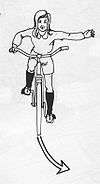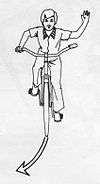Hand signals
Hand signals are given by cyclists and some motorists to indicate their intentions to other traffic. Under the terms of the Vienna Convention on Traffic, bicycles are considered to be vehicles and cyclists are considered to be drivers. The traffic codes of most countries reflect this.
In some countries (such as in the Czech Republic,[1] Canada, and the United States), hand signals are designated not only for cyclists, but for every vehicle that does not have signal lights or has damaged signal lights. For example, drivers of older cars and mopeds may be required to make hand signals.
Similar to automobile signaling, there are three primary signals: Left turn/overtaking, Right turn, and Stopping/braking.
Left turn/overtaking

- All Countries
- Extend left arm straight out in the direction of the turn, horizontally.
Right turn

US and Canada, (optional): Current convention for signaling right, either while cycling in traffic or cycling with other riders, is to extend the right arm perpendicularly to the body; to wit, the cyclist arm is pointing in the same direction of the intended turn.[2] Prior to the common sense approach of extending right arm to indicate a right turn, the convention was for cyclist to extend the left upper-arm out to the left, horizontally and angle your forearm vertically upward"; this practice is no longer in use due to safety concerns. The Uniform Vehicle Code in the US recognizes both signals; although, the Code strongly encourages cyclists to use the arm to the right technique. State traffic laws generally conform to the Uniform Vehicle Code, but exceptions may exist. British Columbia (Canada) recognizes both.
Arm to the right has the advantage that it is more visible to any traffic likely to be affected, for example vehicles in the next lane to the right or also intending to turn right. It is also easier to teach to children: "point in the direction you are going to turn."
Stopping/braking
- UK and Ireland
- Extend your right arm directly out to the right horizontally with palm facing down and slowly wave the extended arm up and down.
- US and Canada
- Extend your left arm out to the left, horizontally and angle your forearm vertically downward.
- Italy
- Extend your right arm vertically, with palm facing forward.
- Australia, Denmark
- Extend your right arm vertically, with palm facing forward, or extend your right upper arm out to the right horizontally and make your forearm vertical with your palm facing forward (as depicted in the US right turn signal above).
Conflict with brake operation
A bicycle's front brake lever is typically installed on the side of the handlebar closest to the center of the road (front-left for right-side driving). In many countries, the hand signal for stopping/braking requires that the cyclist signal with the hand used for the front brake. The front brake is the most effective method of stopping a bike under normal road conditions.[3]
Cyclists, like all other road users, should be ready to make an emergency stop at all times. When approaching a junction a cyclist may wish to "cover the brake" in readiness for an emergency stop. It is not possible to cover both brakes when performing a hand signal and both hands are needed on the handlebars to steady the bicycle under hard braking. Cyclists therefore sometimes have to choose between giving a hand signal and covering the brake.
See also
References
- ↑ The law of the Czech Republic: 361/2000 Sb., § 30
- ↑ http://www.dgt.es/PEVI//documentos/catalogo_recursos/didacticos/did_adultas/conduccion_bicicletas.pdf
- ↑ http://sheldonbrown.com/brakturn.html